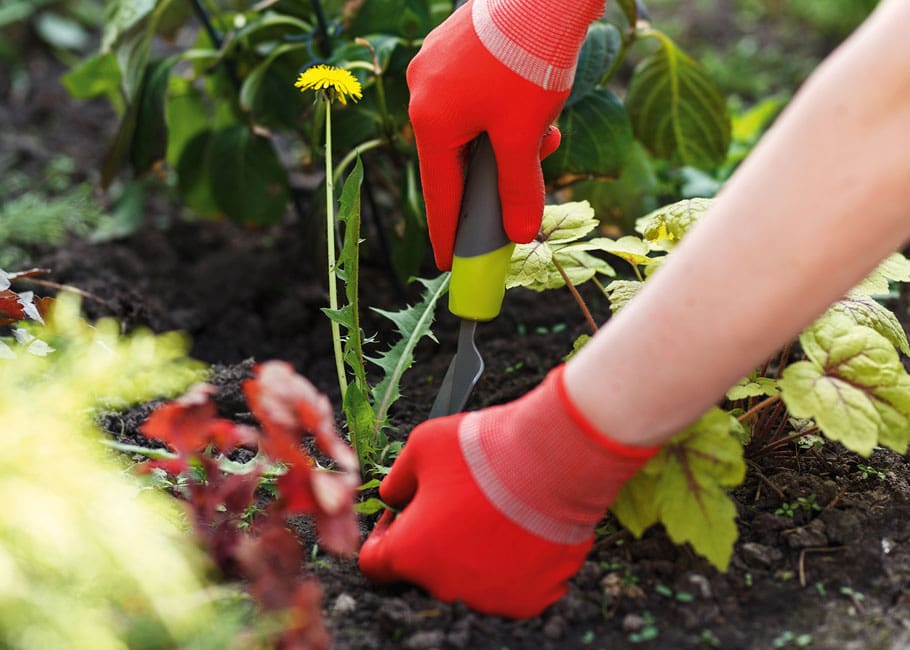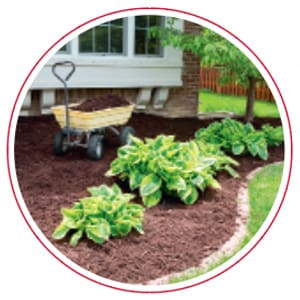Special Section // HOME & GARDEN

© MAKSIM KOSTENKO
Into the weeds
Managing weeds in your landscape or hardscape
by ROSIE WOLF WILLIAMS
Your garden looks beautiful after clearing winter debris and planting spring annuals. But soon, pesky weeds will be poking up through those clean beds.
“Weed control in an urban setting is critical for overall aesthetics,” says Jessica Enns, general manager of the Western Applied Research Corporation, a non-profit agriculture research group based in Scott, Saskatchewan. “Weeds can also compromise the structural integrity of your hardscape, including your pathways, patio stones and retaining walls.
Weeds in a landscape setting are a major concern for competition for natural resources. “It’s important to get an early control of weeds to avoid an infestation that can cause overcrowding, which results in nutrient and water stress that can compromise the health of your desired plants,” says Enns.
Here’s a look at some options for weed control.
Weeding au naturel
If you prefer to manage weeds naturally, sheets of cardboard placed over weeds will help smother them. Landscape fabric, also known as landscape upholstery, works by covering the soil to prevent weeds from self-seeding and restricting sunlight that encourages weed growth. When used in hardscape areas—the non-living elements in landscaping—landscape fabric is best used under rock. This keeps the rocks on top of the soil and reduces the chance of weed growth between the rocks.
If your focus is to nourish plant growth but still reduce the weeds, mulch is a better choice. A heavy application of mulch can keep weed seeds from germinating, smother weeds already in place and eventually add nutrients to the soil.
“Weeds are plants growing where we don’t want them,” says Costco member Joe Omielan, scientist at the Department of Plant & Soil Sciences at the University of Kentucky. “To make life easier for you, remember to feed and water your plants, not the weeds. We want our plants to be more competitive than the weeds. For instance, only work in fertilizer or compost close to your plants in the flower bed, rather than spreading it over the surface of the whole area. This way the shallow-rooted weed seedlings will not have easy access to those resources.”
Omielan suggests setting up soaker hoses in flower beds to direct water to your plants and not nearby weeds. “Remember that the size of the above-ground foliage we see is supported by proportionally sized roots. Mow your lawn at the recommended height for your region and season so the grass plants have roots deep enough for vigorous growth and drought tolerance.”
Chemistry involvement
To minimize the harm to other nearby plants, it’s best to pull weeds by hand or directly spray weeds with a solution of water and vinegar or herbicides. This is easier to do in a hardscape, where plants are contained. You can also use a string trimmer to cut weeds before they go to seed, along with a herbicide that stays active in the soil for an extended period of time and prevents the germination of weed seeds.
Herbicides and other chemical treatments should be used with care even in a hardscape, cautions Joe Neal, professor of weed science at North Carolina State University in Raleigh. “Don’t use any herbicides on hardscapes that you would not use around landscape planting. The roots of plants will grow under porous landscapes, so any herbicide you apply will be encountered by the roots of desirable trees and shrubs,” says Neal. “Herbicides applied to weeds in the cracks of non-porous hardscapes can wash off into the surrounding vegetation. I’ve seen dead turf where herbicides washed from sidewalks onto the lawn. The simple way to avoid injury to desirable plants is to use only herbicides labelled for use in the adjacent lawn or landscape.”
Not all weed seeds require light for germination and some can escape natural control measures like landscape fabric or mulch. And not all weed seeds are controlled by the herbicides in weed and feed products. Weed killers, or postemergence herbicides, are chemical applications that will kill existing weeds. “Each type of herbicide has its unique properties and uses,” says Neal. “Before using any herbicide, do your research to make sure you are using the right product for the task.”
Decide what you want to accomplish in your garden or hardscape, and take the surrounding area into account. Then choose the proper product, to achieve selective weed control and a healthy and attractive garden. “It is important to use them as directed on the label,” says Omielan. “It’s always best to ask for advice ahead of time rather than having to deal with the consequences of a misapplied product.”

© OZGUR COSKUN / STOCK.ADOBE.COM
Types of mulches
Choose a mulch depending on your particular needs, including weed control, aesthetics, size of the area, duration of the mulch, etc.
Mulches fall into two broad categories: organic mulches and synthetic mulches. Organic mulches are any type of mulch that was once alive: leaves, wood chips, straw (never use hay–it is full of weed seeds), sawdust, coconut fibre, grasses or bark. If organic mulch is applied directly on the soil, it will break down into the soil and supply nutrients for the plant’s roots.
Synthetic mulches combine bonding agents with natural or synthetic fibres and are made of ground rubber, landscape glass, plastic or other materials. Some are made with recycled materials such as tires, but others are specially produced as mulch.—RWW
Rosie Wolf Williams is an award-winning writer based in Vermont.
Costco Connection: You’ll find landscape fabric, mulch, herbicides and other lawn and garden supplies in Costco warehouses and Costco.ca.



